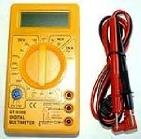
Electrical Testing Equipment
Multi Meter

Multi Meters are multi functional meters, capable of measuring several things, most can measure both DC and AC voltage, resistance, diodes, some can test transistors, and so on. For the type of material I have covered on website the functions that you will likely use the most often is AC voltage and continuity.
A lot of multi meters can measure some current but I would recommend using a clamp on current meter for current reading and not use the multi meter for that function as it relates to home electrical. Setting the multi meter to the wrong function or range could result in damage to the meter itself or cause the internal fuse to blow, so before first use be sure to understand all the functions and to read the documentation that comes with it.
For greater safety – the electrical safety authority is now recommending using only multi meters with fused leads
You can buy an analog one which is one with a dial meter or a digital one, I prefer the digital ones as it is easy to read. You can get simplified meters that only do one or two functions such as voltage only.
I intend at some time to produce a demo video on the use of a multi meter but for now…
To read AC voltage…
- Make sure the meter is set for AC voltage and the probes are inserted into the correct holes in the meter to read AC voltage, there is so many different types of meters and if in doubt refer to the documentation that came with the meter.
- Make sure the range is set correctly, if you expect to see 110 – 120 volts then set the meter higher likely 200 volt range, if you are trying to read 220 -240 volts then set the range for 250 or 300 volts, in other words set the range just above the max of what is expected.
- Make certain that the probes do not touch anything other the one contact point you wish to touch otherwise a short could occur.
Definitions: Ungrounded conductor – HOT; grounded conductor – NEUTRAL; equipment grounding conductor (ground)
For measuring AC voltage, the most common measurement would be between hot and neutral, hot and ground, two hots (in 220 – 240 volt circuits)
Obviously power must be live to read voltage.
WHILE EXTREME CARE HAS BEEN IMPLEMENTED IN THE PREPARATION OF THIS SELF-HELP DOCUMENT, THE AUTHOR AND/OR PROVIDERS OF THIS DOCUMENT ASSUMES NO RESPONSIBILITY FOR ERRORS OR OMISSIONS, NOR IS ANY LIABILITY ASSUMED FROM THE USE OF THE INFORMATION, CONTAINED IN THIS DOCUMENT, BY THE AUTHOR and / OR PROVIDER.
By: Donald Kerr